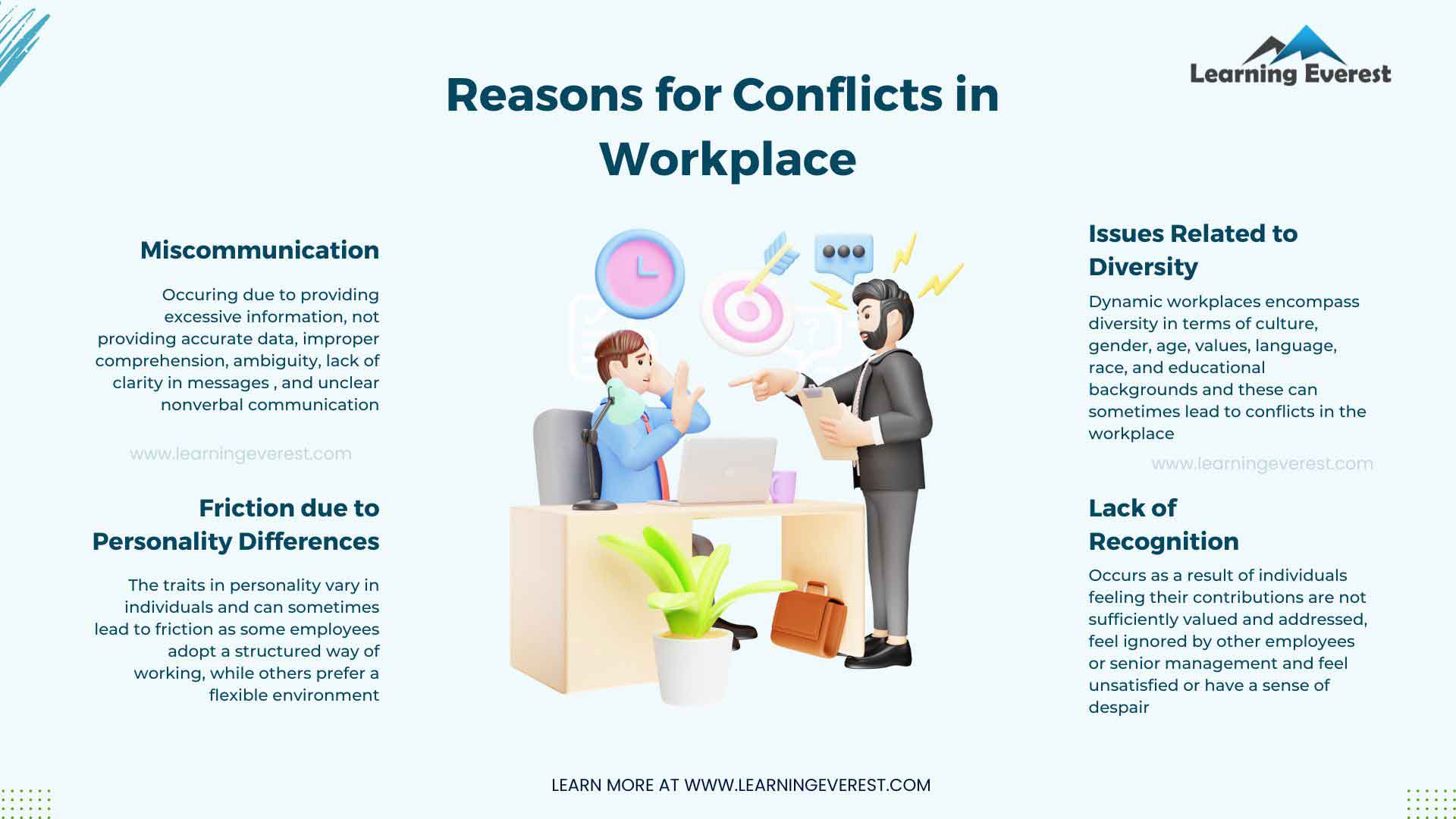What is conflict?
The conflict, according to the Cambridge dictionary, is “an active disagreement between people with opposite opinions or principles”. Work conflicts involve all types of disagreements and discord that occur between employees or management during and outside working hours. Conflicts that can take place in an organization can be interpersonal conflicts or intergroup conflicts and may vary from small tensions and disputes to disputes. If it is not discussed or managed at the appropriate time, it can hinder overall productivity and the results of the organization.
Probable reasons for work conflicts
Organizations are faced with work conflicts based on disagreements between two parties in various fields. These conflicts have their roots in many factors and some of the probable reasons for the conflict are:


Reasons of conflicts in the workplace
Bad communication
Conflicts resulting from poor communication or misinterpretation are a major reason for work conflicts. These may occur due to the provision of excessive information, not to provide precise data, a poor understanding due to passive listening, ambiguity, lack of clarity of messages in the process of transmission and unclear non-verbal communication. In addition to the human -oriented factors of poor communication, technological problems and dysfunctions can lead to communication failures and erroneous interpretations.
Friction due to personality differences
A team includes employees with various personality traits such as outgoing and reserved, practical and imaginative, logical, spontaneous, very creative, etc. These multifaceted personality features vary depending on individuals and can sometimes lead to friction while some employees adopt a structured way of work, while others prefer a flexible environment. According to the global CPP Human capital Report on work conflicts, “49% of work conflicts are caused by personality clashes and ego problems”.
Diversity related problems
Dynamic workplace Include diversity in terms of culture, sex, age, values, language, race and education in education. Cultural misunderstandings and preconceived concepts can sometimes cause conflicts to the workplace. Although organizations embrace Diversity and inclusionConflicts concerning these differences arise due to different mentalities. The resolution of these conflicts is essential for the overall efficiency of the organization. Harvard Business Review stipulates that “… the increase in demographic diversity does not increase effectiveness in itself, what matters is the way in which an organization exploits diversity …”
Lack of recognition
Lack of recognition is a major problem resulting in conflicts in the workplace. This can happen because individuals believe that their contributions are not sufficiently appreciated and discussed, feel ignored by other employees or senior executives leading to frustration, and feel dissatisfied or have a feeling of despair. Conflicts resulting from insufficient recognition can lead employees to leave the organization or increase turnover with a negative impact on overall productivity.
8 tactics on how to manage conflicts in the workplace
Conflicts at the workplace are inevitable but must be treated or resolved enough at the right time. Avoid and deal with conflicts at work promotes relationships, Increases productivityAnd promote growth and innovation opportunities. Here are 8 beneficial tactics to follow in organizations for maximized results.
How to manage conflicts #tactics 1: respect opinions
A key strategy The management of work conflicts is to respect the opinions of other employees. This encourages open discussions and instill in the feeling of being valued to promote collaboration. In addition to the individuals training while respecting and worth each other, organizations can ensure that they promote a Culture of the workplace.
How to manage conflicts #Tactics 2: Culture of inclusiveness
To embrace a culture of inclusiveness in the workplace is a vital strategy to be carried out to deal with work conflicts. A white paper by Clever noted that “inclusive decision -making leads to better decisions up to 87% of the time”. Inclusivity opens the way to support people with differences, promotes active listening and encourages safety environment promoting a productive workplace.
How to manage conflicts #tactics 3: open communication
Promote open and honest communication Within the teams, the teams facilitate conflict resolution. Expressing concerns and resolving communication problems is essential to identify problems at the initial stage and provide effective solutions. When workplaces encourage employees to be honest by expressing their thoughts and welcoming them, this prevents erroneous interpretations and tensions.
How to manage conflicts #tactics 4: Regular comments
It is necessary to practice impartial, precise and regular comments to deal with conflicts in the workplace. The comments open the ground to clarify the little clear problems and inform employees of the necessary areas of the change supply solutions. In addition to being a solution to conflict management, constructive comments prevent conflicts from taking place.
How to manage the #Tactics 5 conflict: Resolve the main cause
The best way to resolve a conflict is to identify the main cause and provide resolution. Focusing on the fundamental question promotes the resolution of the real problem and reduces the probability that the problem was arising next time. The identification of the main cause is to choose a mediator to create a global analysis of the situation by collecting information from the two parties involved in the conflict.
How to manage #Tactics 6 conflicts: provide training
For holistic growth and the development of the workplace, Organizations adopt various training courses. According to LinkedIn Workplace Report 2025, “8 out of 10 people say that learning adds an objective to their work”. In addition to the specific training in the subject based on the roles of employees, general training such as Conflict management trainingConflict resolution training, Intercultural trainingDEI training, Leadership trainingProblem solving training, etc. Acts as a way to deal with conflicts in the workplace.
How to manage conflicts #tactics 7: Documentation
Appropriate documentation of all aspects of work is one of the tactics to resolve the occurrence of conflicts and resolve the conflict that occurred. In addition to serving the objective of supporting evidence and the opposite allegations of the questions, the documentation guarantees equity and consistency in all aspects of the work. In addition, all stakeholders when they are aware of the practice of documentation responsible for their actions.
How to manage #Tactics 8 conflicts: Ensure transparency
Ensuring that all aspects of work and internal communication within the organization are transparent is a fruitful means of managing conflicts. Organizations can ensure transparency by providing regular updates, encouraging open communication and impartial decision -making. The integration of transparency strengthens mutual trust between employees making work smoother.
Conclusion
To summarize, to face conflicts in the workplace is essential to maintain productivity and adopt a positive work environment. Conflicts can take place in an organization due to poor communication, to friction due to differences in personality traits and temperaments, problems concerning diversityand lack of recognition. For the question of how to manage conflicts in the workplace, 8 tactics can be implemented. These strategies include respect for various opinions, promote a culture Inclusive, allowing open communication and regular feedback, identification and resolution of the fundamental causes of conflicts to prevent future disputes, the maintenance of documentation and transparency. By implementing these tactics in the workplace, organizations can prevent and reduce potential conflicts and promote a Culture of inclusion Workspace.
Infographic
Knowledge verification!
Frequently asked questions (FAQ)
How to manage conflicts in the workplace?
To deal with conflicts at the workplace, adopt the tactics of respect for various opinions, to promote a culture of inclusiveness, to allow open communication and regular comments, to identify and resolve the fundamental causes of conflicts to prevent future conflicts, to maintain the practice of documentation and to ensure transparency.
What is a conflict?
The conflict, according to the Cambridge dictionary, is “an active disagreement between people with opposite opinions or principles”.
What is the labor conflict?
Work conflicts involve all types of disagreements and discord that occur between employees or management during and outside working hours.
What are the reasons for work conflicts?
Conflicts can take place in an organization due to poor communication, to friction due to differences in personality traits and temperaments, questions concerning diversity and lack of recognition.



